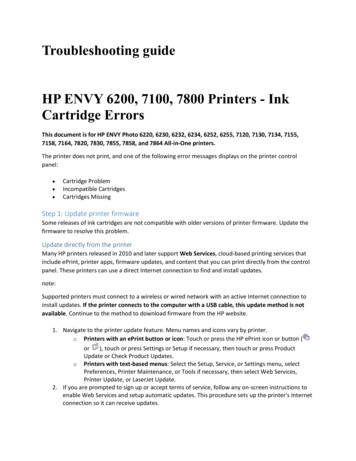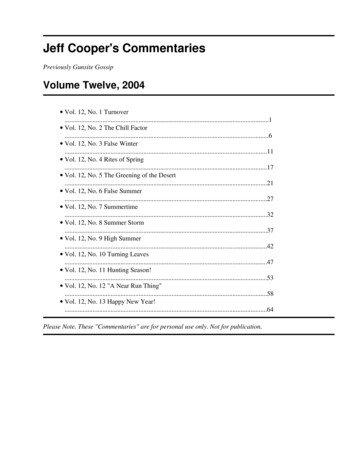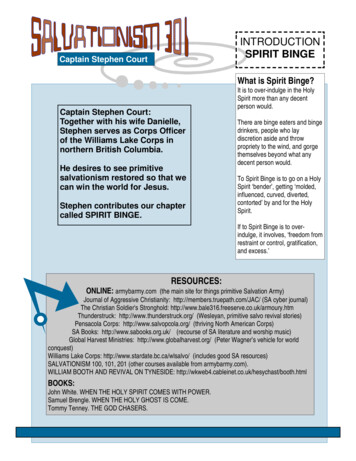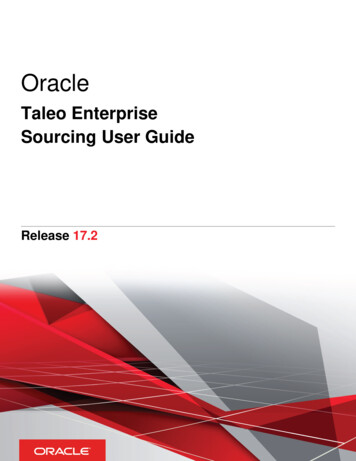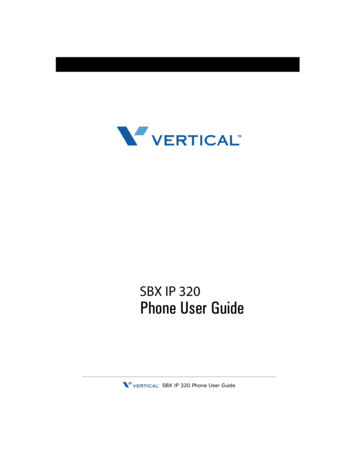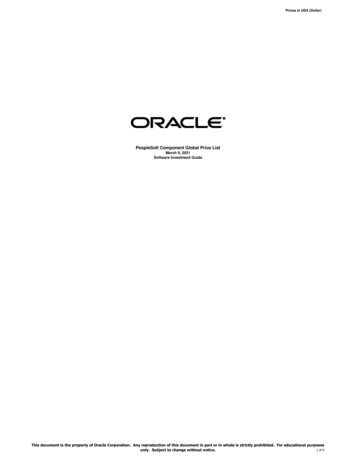
Transcription
HP Envy 15 User Guide
Copyright 2009 Hewlett-PackardDevelopment Company, L.P.Microsoft and Windows are U.S. registeredtrademarks of Microsoft Corporation.Bluetooth is a trademark owned by itsproprietor and used by Hewlett-PackardCompany under license. SD Logo is atrademark of its proprietor.The information contained herein is subjectto change without notice. The onlywarranties for HP products and services areset forth in the express warranty statementsaccompanying such products and services.Nothing herein should be construed asconstituting an additional warranty. HP shallnot be liable for technical or editorial errorsor omissions contained herein.First Edition: September 2009Document Part Number: 572050-001Product noticeThis user guide describes features that arecommon to most models. Some featuresmay not be available on your computer.
Safety warning noticeWARNING! To reduce the possibility of heat-related injuries or of overheating the computer, do notplace the computer directly on your lap or obstruct the computer air vents. Use the computer only on ahard, flat surface. Do not allow another hard surface, such as an adjoining optional printer, or a softsurface, such as pillows or rugs or clothing, to block airflow. Also, do not allow the AC adapter to contactthe skin or a soft surface, such as pillows or rugs or clothing, during operation. The computer and theAC adapter comply with the user-accessible surface temperature limits defined by the InternationalStandard for Safety of Information Technology Equipment (IEC 60950).iii
ivSafety warning notice
Table of contents1 Notebook tourIdentifying hardware . 1Components . 2Top components . 2TouchPad . 2TouchPad buttons . 2Lights . 3Button . 4Keys . 5Front components . 6Right-side components . 6Left-side components . 7Bottom components . 8Display components . 9Wireless antennas . 9Additional hardware components . 10Labels . 112 Using Instant On Software (select models only)3 Wireless and local area networkUsing wireless devices . 13Identifying wireless and network status icons . 13Using the wireless controls . 14Using the wireless key . 14Using Wireless Assistant software . 15Using operating system controls . 15Using a WLAN . 16Setting up a WLAN . 16Protecting your WLAN . 16Connecting to a WLAN . 17Roaming to another network . 18Using Bluetooth wireless devices . 19Bluetooth and Internet Connection Sharing (ICS) . 19Troubleshooting wireless connection problems . 20Cannot connect to a preferred network . 20Network icon for WLAN is not displayed . 20Current WLAN network security codes are unavailable . 20WLAN connection is very weak . 21v
Cannot connect to the wireless router . 21Connecting to a local area network (LAN) . 224 Pointing devices and keyboardUsing pointing devices . 23Setting pointing device preferences . 23Using the TouchPad . 23Using TouchPad gestures . 23Scrolling . 24Pinching . 24Rotating . 24Using the action keys . 26Using the hotkeys . 28Cleaning the TouchPad and keyboard . 295 MultimediaMultimedia features . 30Adjusting the volume . 30Using the media activity keys . 31Multimedia software . 32Using HP MediaSmart software . 32Using multimedia software . 32Installing multimedia software from a disc . 33Audio . 34Connecting external audio devices . 34Checking your audio functions . 34Using Beats Audio . 35Video . 36Connecting an external monitor or projector . 36Connecting an HDMI device . 37Configuring audio for HDMI . 38Webcam . 39Webcam tips . 39Adjusting webcam properties . 39Using the ambient light sensor . 41Using adaptive brightness . 41Using the webcam IR light . 416 Power managementSetting power devices . 43Using power-saving states . 43Initiating and exiting Sleep . 43Initiating and exiting Hibernation . 44Conserving power . 44Using the battery meter . 44Using power plans . 45Viewing the current power plan . 45Selecting a different power plan . 45Customizing power plans . 45vi
Setting password protection on wakeup . 46Using external AC power . 47Connecting AC power . 47Testing an AC adapter . 48Using battery power . 49Identifying batteries . 49Finding battery information in Help and Support . 49Using Battery Check . 49Displaying the remaining battery charge . 50Removing or inserting the primary battery . 50Charging a battery . 51Maximizing battery discharge time . 52Managing low battery levels . 52Identifying low battery levels . 52Resolving a low battery level . 53Resolving a low battery level when external power is available . 53Resolving a low battery level when a charged battery isavailable . 53Resolving a low battery level when no power source isavailable . 53Resolving a low battery level when the computer cannot exitHibernation . 53Using the accessory battery (select models only) . 53Identifying the accessory battery components . 54Inserting or removing an accessory battery . 54Battery charging and discharging sequence . 56Calibrating a battery . 56Storing a battery . 57Disposing of a used battery . 57Replacing the battery . 57Shutting down the computer . 587 Drives and external devicesDrives . 59Identifying installed drives . 59Handling drives . 59Improving hard drive performance . 60Using Disk Defragmenter . 60Using Disk Cleanup . 60Using HP ProtectSmart Hard Drive Protection (select models only) . 61Identifying HP ProtectSmart Hard Drive Protection status . 61Managing power with a parked hard drive . 61Using HP ProtectSmart Hard Drive Protection software . 62Using external drives . 62Connecting optional external drives . 62Using the external optical drive (select models only) . 63Removing an optical disc when the disc tray will not open . 63Sharing optical drives . 64External devices . 66Using a USB device . 66vii
Connecting a USB device . 66Removing a USB device . 66Using an eSATA device . 67Connecting an eSATA device . 67Removing an eSATA device . 67Using Digital Media Slot cards . 68Inserting a digital card . 68Removing a digital card . 698 Memory modules9 SecurityProtecting the computer . 75Using passwords . 76Setting passwords in Windows . 76Setting passwords in Setup Utility . 77Administrator password . 77Managing an administrator password . 78Entering an administrator password . 78Power-on password . 78Managing a power-on password . 79Entering a power-on password . 79Using antivirus software . 80Using firewall software . 81Installing critical security updates . 82Installing an optional security cable . 83Appendix A Setup Utility (BIOS)Starting Setup Utility . 84Using Setup Utility . 85Changing the language of Setup Utility . 85Navigating and selecting in Setup Utility . 85Displaying system information . 86Restoring default settings in Setup Utility . 86Exiting Setup Utility . 86Setup Utility menus . 87Main menu . 87Security menu . 87System Configuration menu . 87Diagnostics menu . 88Updating the BIOS . 89Updating the BIOS . 89Determining the BIOS version . 89Downloading a BIOS update . 89Appendix B Backup and recoveryCreating recovery discs . 92Backing up your information . 93Using Windows Backup and Restore . 93viii
Using system restore points . 94When to create restore points . 94Create a system restore point . 94Restore to a previous date and time . 94Performing a recovery . 95Recovering from the recovery discs . 95Recovering from the dedicated recovery partition (select models only) . 95Appendix C RAID 0 (select models only)Disabling RAID 0 . 97Index . 98ix
x
1Notebook tourIdentifying hardwareTo see a list of hardware installed in the computer: Select Start Control Panel System and Security. Then in the System area, click DeviceManager.You can also add hardware or modify device configurations using Device Manager.NOTE: Windows includes the User Account Control feature to improve the security of your computer.You may be prompted for your permission or password for tasks such as installing applications, runningutilities, or changing Windows settings. Refer to Help and Support for more information.Identifying hardware1
ComponentsTop es the pointer and selects or activates items on the screen.*This table describes factory settings. To view and change pointing device preferences, select Start Devices and Printers.Then, right-click the device representing your computer, and select Mouse settings.TouchPad buttons2Chapter 1 Notebook tour
ComponentDescription(1)TouchPad on/off buttonTurns the TouchPad on and off. Lightly press the button and holdfor two seconds to turn the TouchPad on and off.(2)Left TouchPad button*Functions like the left button on an external mouse.(3)Right TouchPad button*Functions like the right button on an external mouse.*This table describes factory settings. To view and change pointing device preferences, select Start Devices and Printers.Then, right-click the device representing your computer, and select Mouse settings.LightsComponent(1)DescriptionTouchPad light Amber: The TouchPad is off. Off: The TouchPad is on.(2)Caps lock lightWhite: Caps lock is on.(3)Power light White: The computer is on. Blinking white: The computer is in the Sleep state. Off: The computer is off or in Hibernation.(4)Mute lightAmber: Computer sound is off.(5)Wireless light Off: An integrated wireless device, such as a wireless localarea network (WLAN) device and/or a Bluetooth device,is on.NOTE: Wireless devices are enabled at the factory.Amber: All wireless devices are off.Components3
ButtonComponentPower buttonDescription When the computer is off, press the button to turn on thecomputer. When the computer is on, press the button briefly to initiateSleep. When the computer is in the Sleep state, press the buttonbriefly to exit Sleep. When the computer is in Hibernation, press the button brieflyto exit Hibernation.If the computer has stopped responding and Windows shutdownprocedures are ineffective, press and hold the power button for atleast 5 seconds to turn off the computer.To learn more about your power settings, select Start ControlPanel System and Security Power Options.4Chapter 1 Notebook tour
KeysComponentDescription(1)Action keysExecute frequently used system functions.(2)wireless keyTurns the wireless feature on or off.NOTE: This key does not establish a wireless connection. Toestablish a wireless connection, a wireless network must also beset up.(3)Windows application keyDisplays a shortcut menu for items beneath the cursor.(4)Windows logo keyDisplays the Windows Start menu.(5)fn keyExecutes frequently used system functions when pressed incombination with a function key or the esc key.(6)calculator keyOpens the Windows calculator function.(7)print options keyOpens the Print Options window of the active Windowsapplication.(8)Web keyOpens a Web browser.NOTE: Until you have set up your Internet or network services,the Web key opens the Windows Internet Connection Wizard. Afteryou have set up your Internet or network services and your Webbrowser home page, you can press the Web key to quickly accessyour home page and the Internet.(9)Media Launch keyOpens HP MediaSmart. HP MediaSmart turns your computer intoa mobile entertainment center. You can enjoy music and moviesand manage and edit your photo collections.(10)mail keyOpens your default e-mail program.Components5
ComponentDescriptionNOTE: The first time you press the mail key, you may beprompted to set up your e-mail account. After you have set up youre-mail, you can press the mail key to quickly access your e-mail.(11)esc keyDisplays system information when pressed in combination with thefn key.Front componentsComponentDescription(1)Enables airflow to cool internal components.Vents (2)NOTE: The computer fan starts up automatically to cool internalcomponents and prevent overheating. It is normal for the internalfan to cycle on and off during routine operation.(2)Digital Media SlotSupports the following digital card formats: MultiMediaCard micro MultiMediaCard (adapter required) MultiMediaCard Plus Secure Digital Memory Card micro Secure Digital Memory Card (adapter required) Secure Digital High Capacity Memory CardRight-side componentsComponentDescription(1)SpeakerProduces sound.(2)Security cable slotAttaches an optional security cable to the computer.NOTE: The security cable is designed to act as a deterrent,but it may not prevent the computer from being mishandled orstolen.6Chapter 1 Notebook tour
Component(3)DescriptionAudio-out (headphone) jack/Audio-in(microphone) jackProduces sound when connected to optional powered stereospeakers, headphones, earbuds, a headset, or televisionaudio. Also connects an optional headset microphone.NOTE: When a device is connected to the jack, the devicespeakers are disabled.(4)eSATA/USB portConnects a high-performance eSATA component, such as aneSATA external hard drive, or connects an optional USBdevice.(5)USB ports (2)Connect optional USB devices.(6)HDMI portConnects an optional video or audio device, such as a highdefinition television, or any compatible digital or audiocomponent.(7)RJ-45 (network) jackConnects a network cable.(8)VentEnables airflow to cool internal components.NOTE: The computer fan starts up automatically to coolinternal components and prevent overheating. It is normal forthe internal fan to cycle on and off during routine operation.Left-side componentsComponentDescription(1) Off: The computer is running on battery power. Blinking amber: The battery has reached a low battery level,a critical battery level, or there is a battery error. Amber: A battery is charging. White: The computer is connected to external power and thebattery is fully charged.Battery light(2)Power connectorConnects an AC adapter.(3)VentEnables airflow to cool internal components.NOTE: The computer fan starts up automatically to cool internalcomponents and prevent overheating. It is normal for the internalfan to cycle on and off during routine operation.Components7
ComponentDescription(4) Blinking white: The hard dri
Lights Component Description (1) TouchPad light Amber: The TouchPad is off. Off: The TouchPad is on. (2) Caps lock light White: Caps lock is on. (3) Power light White: The computer is on. Blinking white: The computer is in the Sleep state. Off: The computer is off or in
